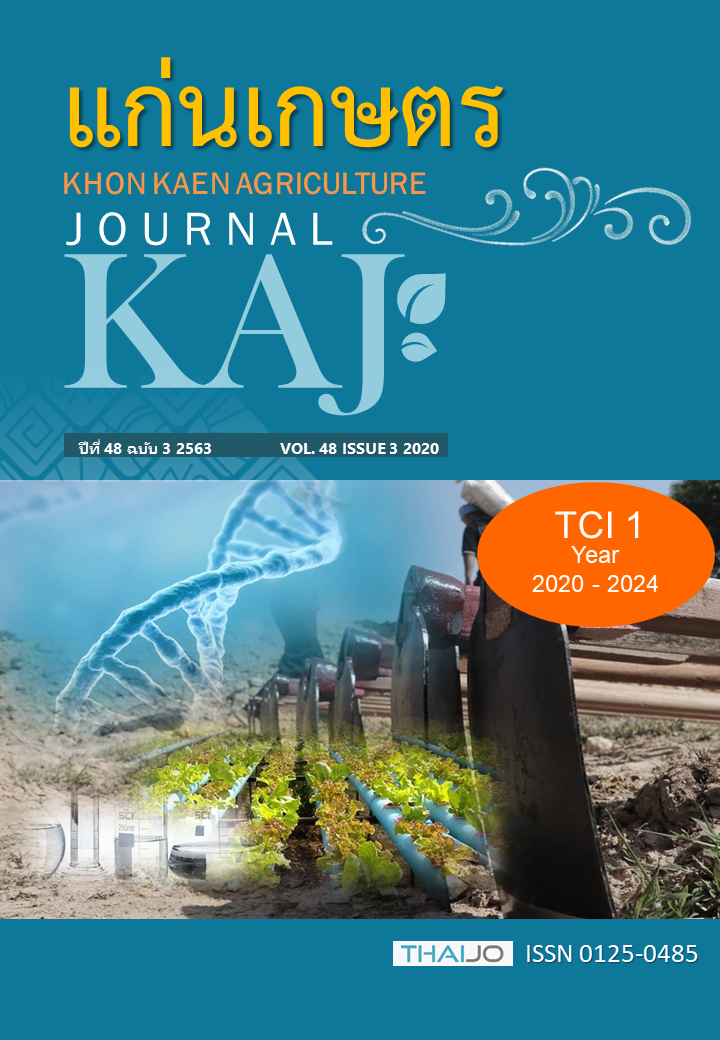คาร์บอนและไนโตรเจนในเม็ดดินขนาดต่าง ๆ ของดินที่ลุ่มที่มีวิทยาแร่ดินเหนียวแตกต่างกันในที่ราบภาคกลางของประเทศไทย
Main Article Content
บทคัดย่อ
คัดเลือกตัวแทนดินที่ลุ่มในบริเวณภาคกลางที่มีแร่ดินเหนียวแตกต่างกัน 5 อันดับดิน ได้แก่ ดินในอันดับอินเซปทิซอลส์ แอลฟิซอลส์ และอัลทิซอลส์ มีแร่องค์ประกอบแบบผสม ดินในอันดับมอลลิซอลส์ และเวอร์ทิซอลส์ มีแร่สเมกไทต์เป็นแร่องค์ประกอบหลัก เก็บตัวอย่างดินชั้นไถพรวน (Ap) และใต้ฐานชั้นไถพรวนถึงระดับความลึก 60 ซม. (Ap-60) เพื่อศึกษาปริมาณและการแจกกระจายขนาดของเม็ดดิน ปริมาณเม็ดดินเสถียร ปริมาณคาร์บอนอินทรีย์และไนโตรเจนรวมในเม็ดดิน ผลการศึกษาพบว่า ปริมาณเม็ดดินขนาดใหญ่ (> 0.25 มม.) และปริมาณเม็ดดินเสถียรน้ำของดินที่ทำการศึกษามีสหสัมพันธ์เชิงบวกกับปริมาณคาร์บอนอินทรีย์ ปริมาณแคลเซียมที่สกัดได้ และปริมาณอนุภาคขนาดดินเหนียวในดินอย่างมีนัยสำคัญทางสถิติ ดินที่ทำการศึกษาส่วนใหญ่มีปริมาณคาร์บอนอินทรีย์และไนโตรเจนรวมในเม็ดดินเพิ่มขึ้นตามขนาดของเม็ดดินในชั้น Ap อย่างไรก็ตามในชั้น Ap-60 ดินในอันดับแอลฟิซอลส์ อัลทิซอลส์ และเวอร์ทิซอลส์ มีปริมาณคาร์บอนอินทรีย์และไนโตรเจนรวมในเม็ดดินขนาดเล็ก (< 0.25 มม.) สูงกว่าเม็ดดินขนาดใหญ่ โดยปริมาณคาร์บอนอินทรีย์และไนโตรเจนรวมในเม็ดดินทุกขนาดมีแนวโน้มเพิ่มขึ้นตามปริมาณคาร์บอนอินทรีย์ในดินอย่างมีนัยสำคัญทางสถิติ ดินแต่ละกลุ่มแร่มีปริมาณการแจกกระจายขนาดของเม็ดดิน ปริมาณเม็ดดินเสถียรน้ำ ปริมาณคาร์บอนอินทรีย์และไนโตรเจนรวมในเม็ดดินแตกต่างกันภายในกลุ่มอย่างชัดเจน ดังนั้น แร่ดินเหนียวในดินอาจมีบทบาทสำคัญต่อการเกิดเม็ดดิน เม็ดดินเสถียรน้ำ ปริมาณคาร์บอนและไนโตรเจนในเม็ดดินน้อยกว่าสมบัติอื่น ๆ ของดิน
Article Details
เอกสารอ้างอิง
พัสกร ทะสานนท์, ทิมทอง ดรุณสนธยา, วิทยา จินดาหลวง, และ ชัยภัทร คงแก้ว. 2561. รูปของโพแทสเซียมในดินนาที่ราบภาคกลางของประเทศไทย. ว.พืชศาสตร์สงขลานครินทร์. 5: 58-66.
อภิรักษ์ จงเหลืองสะอาด. 2561. คาร์บอนอินทรีย์และไนโตรเจนในอนุภาคขนาดต่าง ๆ ของดินตะกอนน้ำพาในบริเวณที่ราบลุ่มภาคกลางของประเทศไทย. วิทยานิพนธ์ปริญญาโท, มหาวิทยาลัยเกษตรศาสตร์.
อภิรักษ์ จงเหลืองสะอาด, วิทยา จินดาหลวง, และ ทิมทอง ดรุณสนธยา. 2560. ปัจจัยทางดินที่ส่งผลต่อปริมาณและการแจกกระจายของคาร์บอนอินทรีย์ในดินตะกอนน้ำพา บริเวณที่ราบลุ่มภาคกลางของประเทศไทย, น. 1-8. ใน: รายงานการประชุมทางวิชาการของมหาวิทยาลัยเกษตรศาสตร์ ครั้งที่ 55 (สาขาพืช). มหาวิทยาลัยเกษตรศาสตร์. กรุงเทพฯ.
Amézketa, E. 1999. Soil aggregate stability: a review. J. Sustain. Agr. 14: 83–151.
Baldock, J.A., and J.O. Skjemstad. 2000. Role of the soil matrix and minerals in protecting natural organic materials against biological attack. Org. Geochem. 31: 697-710.
Barthès, B.G., E. Kouakoua, M.C. Larré-Larrouy, T.M. Razafimbelo, E.F. de Luca, A. Azontonde, S.V.J. Carmen, P.L. de Freitas, and C.L. Feller. 2008. Texture and sesquioxide effects on water-stable aggregates and organic matter in some tropical soils. Geoderma 143: 14-25.
Christensen, B.T. 2001. Physical fractionation of soil and structural and functional complexity in organic matter turnover. Eur. J. Soil Sci. 52: 345–353.
Denef, K., J. Six, R. Merckx, and K. Paustian. 2002. Short-term effects of biological and physical forces on aggregate formation in soils with different clay mineralogy. Plant Soil. 246: 185-200.
Elliott, E.T. 1986. Aggregate structure and carbon, nitrogen and phosphorous in native and cultivated soils. Soil Sci. Soc. Am. J. 50: 627–633.
Elliott, E.T., C. Palm, D. Reuss, and C. Monz. 1991. Organic matter contained in soil aggregates from a tropical chronosequence: correction for sand and light fraction. Agr. Ecosyst. Environ. 34: 443-451.
Eswaran, H., E. van den Berg, and P. F. Reich. 1993. Organic carbon in soils of the world. Soil Sci. Soc. Am. J. 57: 193-194.
Feller, C., and M.H. Beare. 1997. Physical control of soil organic matter dynamics in the tropics. Geoderma 79: 69-116.
Kahle, Kahle, M., M. Kleber, M. S. Torn, and R. Jahn. 2004. Retention of dissolved organic matter by phyllosilicate and soil clay fractions in relation to mineral properties. Org. Geochem. 35: 269-276.
Kemper, W.D., and R.C. Rosenau. 1986. Aggregate stability and size distribution. pp. 425-442. In: A. Klute. Methods of Soil Analysis, Part I: Physical and Mineralogical Methods. Agronomy, No. 9 (Part 1). Amer. Soc. Agron., Madison, Wisconsin USA.
National Soil Survey Center. 1996. Soil Survey Laboratory Methods Manual. Soil Survey Invest Report No. 42, Version 3.0 U.S. Dept of Agr., U.S. Government Printing Office, Washington D.C.
Nelson, D. W., and L. E. Sommers. 1996. Total carbon, organic carbon, and organic matter. pp. 539-579. In: A. L. Page, R. H. Miller, and D. R. Keeney. Methods of Soil Analysis, Part II: Chemical and Microbiological Methods Properties. Am. Soc. Agron. Inc., Madison, WI.
Six, J., K. Paustian, E.T. Elliott, and C. Combrink. 2000. Soil structure and organic matter: I. Distribution of aggregate-size classes and aggregate- associated carbon. Soil Sci. Soc. Am. J. 64: 681-689.


